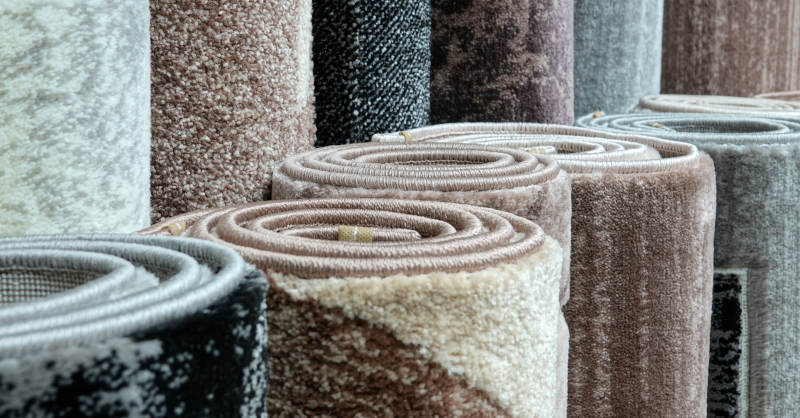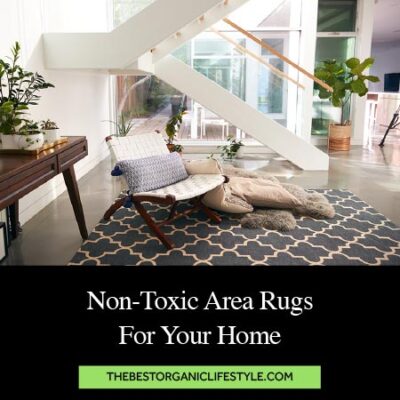Disclosure: This post may contain affiliate links. I receive a small commission at no cost to you when you make a purchase using my link.

Synthetic rugs are produced with the help of man-made fibers like polypropylene, also known as olefin, acrylic, polyester, and nylon. These materials are made in a laboratory from petroleum and are then distributed throughout factories in order to be machine-woven into rugs. Though there is a minor difference in color and texture between the materials, in most cases, the average individual cannot differentiate between them. The manufacturer chooses the most appropriate synthetic material for the type of carpet or rug they want to produce.
These four materials are derivatives of petroleum and are chemically-treated with various compounds whose impact on the human health and environment is definitely not a good one. Nonetheless, this does not seem to avert customers from buying them; to illustrate, in 2007, Americans purchased more than a billion square yards of carpeting, which is more than the whole land of New York City, as pointed out by Julie Scelfo from the New York Times.

The Characteristics of Polypropylene Area Rugs
The average lifespan of synthetic rugs is around 3 to 5 years – if they are professionally cleaned on a regular basis. They are not as resilient to foot traffic as wool rugs and since they do not have a natural spiral structure, the fibers are usually torn down as a consequence of heavy furniture and high foot traffic.
In order to become resistant to stains or to achieve other characteristics like anti-static and antibacterial, polypropylene is mixed with different chemical substances. It is cheaper than nylon and it is considered to be a material with low tolerance to abrasion and a low melting point.
This material is frequently chosen for the production of affordable rugs due to its strength to take a lot of forms and because it can be used for a variety of rugs, i.e. from soft shaggy to flat-woven kitchen rugs. The fibers for these rugs are inexpensive and since they are not handmade, they are weaved by appropriate machines in just a couple of hours.
However, though you do not have to spend a small fortune on such rugs and though there are a variety of models to choose from, a lot of people are concerned whether they should opt for rugs made from polypropylene as they contain a lot of dangerous toxins that could cause serious health issues, which is not the case with rugs that are made from natural and sustainable materials.

Pros:
- Cheap fiber.
- High resistance to staining (except oil stains).
- Resistant to bleaches and fading due to sunlight because of being dyed.
- Easy for cleaning.
Cons:
- Poor resilience and prone to crushing.
- Treated with harmful chemicals.
- Not recommendable for areas with high foot traffic.
- Oil-based stains are not easily removed so they are not recommended for kitchens or dining rooms.

The Health Risks Associated with Polypropylene Rugs and the Environmental Impact
Most synthetic rugs and carpets are treated with fire retardants, stain protectors, and insecticides. They also have VOC’s that release the ‘new carpet’ odor and this could trigger serious health complications from allergies to nausea. These VOC’s gas off-gas for up up 5 years!
Unfortunately, all varieties that are synthetic have a latex mix that contains styrene, a potential cancerous substance. This is why it is crucial to air out new synthetic rugs before setting them up and leaving the doors and windows opened up for at least 48 hours until the off-gassing stops.
Most of materials, whether they are natural or synthetic, influence the environment in this or that way and those used for rug manufacturing are no exception. According to experts, even though synthetic rugs and carpets have a rather short lifespan at home, it takes hundreds of years for them to degrade in a landfill due to the slow breakdown of the substances and materials involved.
So, carpet recycling centers can be of great aid. Since 2002 when it was founded, the non-profit organization Carpet America Recovery Effort has successfully redirected 5 billion pounds of post-consumer carpet from U.S. landfills. Their primary goal is to develop the necessary infrastructure for successful recycling of carpets and rugs.
Questionable Materials Present in Polypropylene Rugs
- Synthetic rubber which may contain phthalates that can disrupt the endocrine function.
- Toxic dyes used for the dying process.
- Glues and other types of adhesive elements that may have formaldehyde and other chemicals.
- Fungicides and pesticides.
- Fire retardants.
- PFCs that can disrupt the endocrine activity and lower the immunity (they are added to synthetic area rugs that are labeled as water-repellent or stain-resistant).
Want a More Natural Option?
If you are looking for a healthy alternative to polypropylene and other synthetic materials, you have plenty of options. Jute, wool, cotton, sisal, and seagrass all make beautiful rugs that are Eco-friendly and sustainable. Read our guide to Non-Toxic Are Rugs for Your Home.

Synthetic Rugs vs. Wool and Jute Area Rugs
Unlike synthetic materials, wool and jute are naturally renewable, biodegradable, sustainable, and eco-friendly.
Wool Area Rugs
Top quality wool usually originates from Australia, Argentina, and New Zealand where sheep are sheered once per year in the spring months after their coat has grown long and they do not need it anymore. Their wool is strong and thick in order to protect them from the harsh weather at high altitudes, but in the same time, it is elastic and soft. As it has lanolin, natural wax that protects from moisture and the elements, wool carpets are naturally resistant to stains and easily cleaned.
Though this is a more expensive material than synthetic fibers, it is a long-term and viable investment because it is highly strong and durable and a wool rug or carpet can last for centuries, while still maintaining its one-of-a-kind properties. As it is naturally water-repellent, wool rugs require no additional chemicals and other treatments to acquire this characteristic, as it is the case with synthetic rugs. They are therefore recommendable for kitchens and dining rooms.
Read: Non-Toxic Area Rugs for Your Home
Jute Area Rugs
Jute is a natural fiber derived from the Jute plant found in India and China and it is mostly used for the making of coarse durable threads and it grows fast during the rainy seasons. It is an easily-shapeable fiber that allows tight braids to chunky weaves without any breakage.
If regularly vacuumed and if the stains are blotted with a towel, jute rugs can last for years and years. They are more recommendable for low to medium traffic areas like a bedroom or a home office.
It is eco-friendly because there is no use of fertilizers or pesticides during the growing period and it does not demand consuming irrigation systems because it depends on rainfall.
Read: Best Natural Fiber Rugs for Every Room
Final Thoughts on the Safety of Polypropylene Area Rugs
Although most people purchase synthetic rugs due to their affordability and their easily-cleanable properties, these rugs have a lot of negative aspects that should definitely be taken into consideration when deciding on a floor covering for your home or office. What is particularly concerning is the presence of dangerous chemicals that can harm the health of you and your loved ones, but mother Earth as well.
When we fail to see the bigger picture and when we want to save money, we can easily end up having a carpet with a short lifespan, poor resilience, and low durability.
However, the economic aspect is sometimes decisive, so you should know how to reduce the negative impact of synthetic rugs and how to prolong their durability.
- Make sure you air out the rug before setting it up and then properly ventilate the room for at least 2 days to minimize the influence of the chemicals on your health.
- To prevent them from losing their shine, make sure you professionally clean them regularly and when you replace it with a new one, check out the recycling options in your town to keep the environment as clean as possible.
Want a More Natural Option?
If you are looking for a healthy alternative to polypropylene and other synthetic materials, you have plenty of options. Jute, wool, cotton, sisal, and seagrass all make beautiful rugs that are Eco-friendly and sustainable. Read our guide to Non-Toxic Are Rugs for Your Home.
What do you think? Is it worth saving some money to have a cheap rug that will last for a few years? Or is it better to invest in a natural, but more expensive rug that will last a long time? Tell us in the comments!
This post was originally written on November 28th, 2019. It was last updated on September 15th, 2020.




Hi, nice website. Very useful information. Wanted to get in touch with you guys (Andrea and Maria) to see if you can help us with something? Your contact us page is blank.
Thank you
Hi there, I got our contact page fixed, there was something wrong with it! You can contact us now 🙂
This is a very informative article.
Please watch this video: https://www.youtube.com/watch?v=72JcZH-NrF4
Here are some rugs made of all natural fibers wool and silk.
https://www.flickr.com/photos/alisrugs/
Wow, that video is crazy! Thanks for sharing
Was about to hit “buy” on a synthetic rug before I read this article. At the end of the day, we all need to change our buying habits and just learn to refuse plastic – whether it’s shopping bags or Polypropylene products in fast fashion and our furniture. I’m going to save up for a vintage carpet to reduce & recycle and be patient with my investment instead of buying a cheap and unhealthy rug right now. Thank you for your info Andrea!
If anyone is looking for more info on how phalates mess with your endocrine system, check out Getting curious with JVN podcast, episode with the founder of Follain!
Thanks for your comment, Miranda!